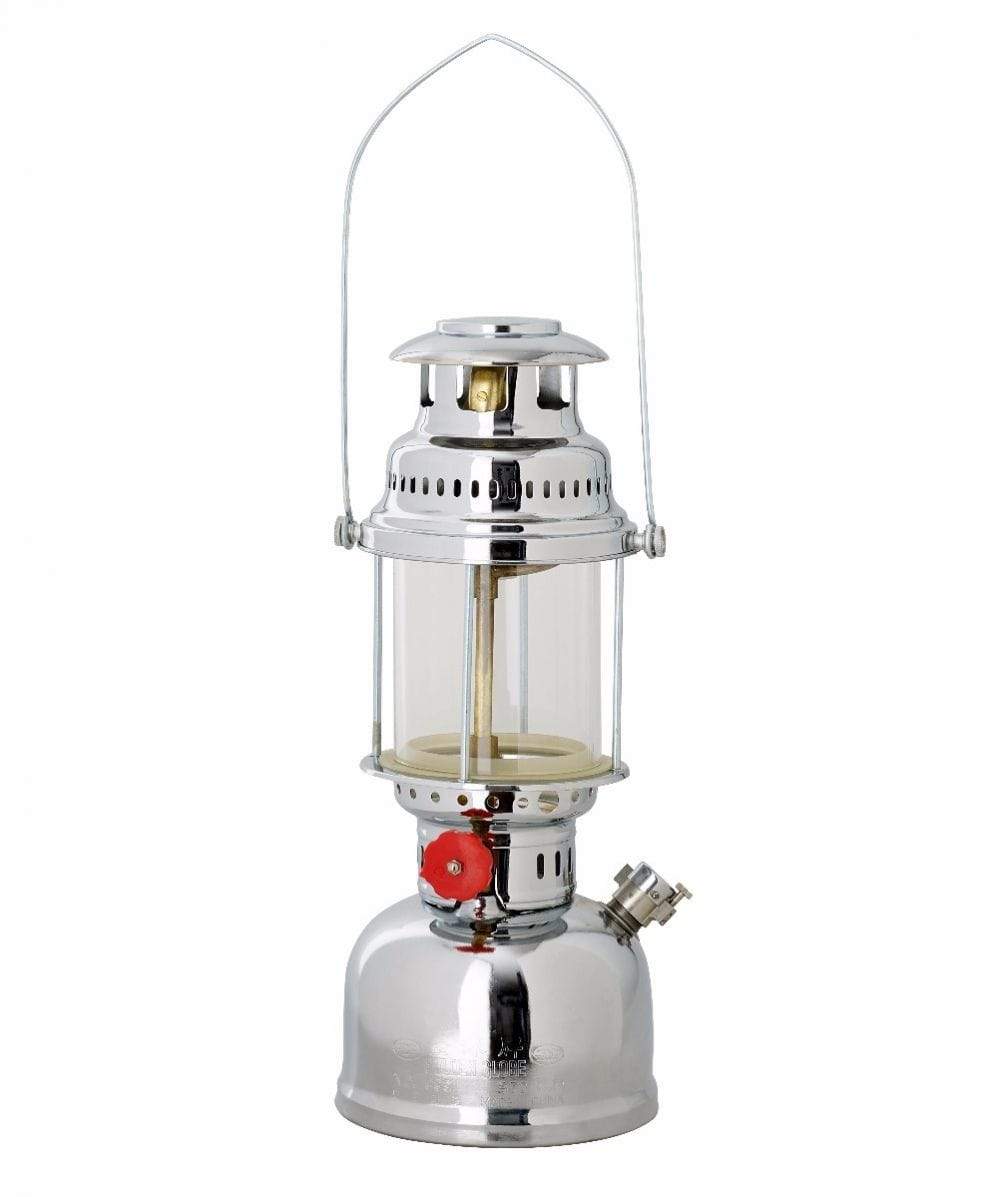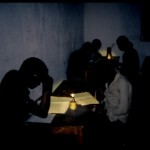About maintenance and functioning of kerosene pressure lamp
I wrote this while working at Kibosho Girls Secondary School in Moshi, Tanzania 1994-95. The relatively well-equipped school had mains electricity, but mains electricity was both rationed out (because of draught in the hydroelectric area) and generally undependable. So the school often used kerosene lamps for evening studies. Kerosene is not a renewable resource, but until solar systems are more affordable, they can be useful. One lamp can give a decent amount of light for a classroom with maybe 50 pupils. The white light is easier on the eyes than the usual yellowish light from wick lamps.
Kerosene PRESSURE LAMP (often called ”karabai”)
It is often called Karabai in Swahili on Tanzania. This is because it gives a strong WHITE light like a CARBIDE lamp. A carbide lamp used a chemical called calcium carbide. It looks like stones. If you drop it in water, the carbide reacts with the water to produce the gas acetylene CaC2+2H2O=2C2H2+Ca(OH)2 (sic, the atoms don’t balance! p 207 Inorg Chem). This gas burns in air with a very white flame because of its high carbon content.
 The kerosene pressure lamp gets its white flame in different way. It has a very efficient way of burning the kerosene. The flame of the lamp heats the pipe which supplies the kerosene to the flame and also the pipe which carries the mixture of gas and air. The kerosene becomes so hot that it becomes a gas which burns easily with the hot air. The hot flame burns in the ”mantle” which is like a small sock made of some metallic oxides that fuse when the mantel is first exposed to flame. (I thought it was on asbestos. Asbestos is a mineral [= from stone} fiber that can stand high temperatures.) After being heated it is easily broken by touching or shaking. The mantle is coated with elements that emit white light when heated. Thorium is commonly used. This substance when heated enough gives out lots of radiation in the form of visible light. An ordinary kerosene lamp will send out much of its energy in the form of invisible infra-red (or heat) waves. So a lot of the energy is lost as heat in an ordinary kerosene lamp.
The kerosene pressure lamp gets its white flame in different way. It has a very efficient way of burning the kerosene. The flame of the lamp heats the pipe which supplies the kerosene to the flame and also the pipe which carries the mixture of gas and air. The kerosene becomes so hot that it becomes a gas which burns easily with the hot air. The hot flame burns in the ”mantle” which is like a small sock made of some metallic oxides that fuse when the mantel is first exposed to flame. (I thought it was on asbestos. Asbestos is a mineral [= from stone} fiber that can stand high temperatures.) After being heated it is easily broken by touching or shaking. The mantle is coated with elements that emit white light when heated. Thorium is commonly used. This substance when heated enough gives out lots of radiation in the form of visible light. An ordinary kerosene lamp will send out much of its energy in the form of invisible infra-red (or heat) waves. So a lot of the energy is lost as heat in an ordinary kerosene lamp.
The substance Thorium is quite radioactive. So you should not have even new unused mantles near your body. You should avoid breathing in the smoke which is given off , especially the first time you light the mantle. The ashes of a broken mantle should be disposed of, so no one will eat or breathe them. Some ashes can also contain asbestos (from the tie string) which, though not radioactive, is not good to breathe in. (Do not put mantel ashes in garden or compost. Wash your hands after handling. Don’t try to burn it up. Just try to place it where you would other poisons. ) More about the radioactive mantle risks | Lime light-A very interesting page about thermoluminescence
There are non-radioactive mantels available that use Yttrium in stead of Thorium. They give somewhat less light but last longer. But if you don’t know what your mantel contains, be careful, as though it was radioactive.
How do you use the pressure lamp? The lamp is rather heavy so you may think there is kerosene inside though it is almost empty. Remove the filling cap which also has a pressure guage on it. Fill with kerosene, but leave some space for some air. Close the cap and also the air screw that is in the cap. Turn the large red knob so its arrow points up. Then a small wire will go up through the kerosene orfice (=small hole). This cleans the hole and also closes it. Since there is no flame in the mantle yet to heat the pipe, we must heat the pipe before we try to light the kerosene. Put some alcohol (=spirits) in the heating cup (=the small yellowish (brass) bowl around the base of the vertical pipe). This can be done with the green plastic can that has a small pipe that can be stuck in through the largest hole near that bowl. Light the alcohol with a match.
While the alcohol is heating the pipe you can start putting in some ”pressure” in the lamp by pumping some air into the lamp with the pump. Sometimes the leather washer in the pump has to be lubricated with vaseline or some other grease to pump well. Try to form the leather so it presses against the sides of the pump cylinder. Don’t press it together more than necessary to get into pump cylinder. If the pressure gauge works, you can pump until it points at the red line. Hold the lamp base firmly while pumping, because each pump stroke shakes the delicate (=easily broken) mantle. Otherwise pump ( 100? ) times. If there is only a little kerosene inside you have to pump many strokes, but it keeps its pressure while burning. If there is a lot of kerosene, you get a high pressure with a few strokes, but the pressure falls as the kerosene level sinks and has to be pumped again.
When there is only about 1 mm of alcohol left in the bowl, open the kerosene flow by turning the red knob so the arrow points down. This lowers the wire out of the orfice. Hot kerosene gases spray into the pipe and also suck air into the pipe which curves back down to the mantle. There, the gases are ignited by the flame of the alcohol. The hot kerosene flame makes the mantle produce a strong white light.
To increase the amount of light around and below the lamp, put on the reflector: Hold the hanging wire (handle) upwards and put the reflector over it, white side down.
You turn off the light by letting out the pressure with the air screw on the filling cap. (You can quickly turn off the lamp by turning the red wheel so it points up, BUT you should let out the pressure too, otherwise some kerosene may leak out at the orfice and make smoke.
The ”chimney” is the clear glass, open-ended, cylinder that protects the flame area from wind. A quick turning off of the lamp can increase the risk of the chimney cracking especially if there is a hole in the mantle.) As with other lamps, if even a drop of water hits the glass chimney when it is hot, the glass can break. Protect it from rain and other water droplets.
What problems can you have? If you open the kerosene flow before the pipe is hot enough, liquid kerosene can spray into the pipe. This can make large flames come out of the lamp. If the lamp is not near anything burnable, this is not dangerous, but turn off the kerosene. The not-hot kerosene can make the mantle get covered with black carbon. This prevents white light from the thorium even if the flame gets hot enough. By turning off the kerosene for a second, air can reach the hot mantle and burn off some carbon. If you quickly open the kerosene flow again before it gets too cold you don’t have to light it again. Let the mantle heat up again some, then repeat (turning off the kerosene) until the mantle is white again.
Sometimes the light decreases and is not helped much by pumping up more pressure. There can be some dirt in/on the orfice. Turn the large red knob around one turn. This pushes the wire through the hole and cleans it. Sometimes the dirt can be just above the orfice and you can push it away with a small stick or wire from the side through the hole near the orfice.
Sometimes you can’t turn off the kerosene completely and this means you can’t burn off the carbon. It can also make kerosene come out before the pipe is hot, causing big flames to come out the top of the lamp. The problem is that the orfice hole and wire are not making a tight fit. Either the wire is too thin or the hole is too big. You will probably have to replace one or both (pin-200sh [=TAS Tanzania shilling in 1995]; orfice-500sh).
Sometimes you can succeed to light the lamp properly, but the mantle gets slowly blacker and blacker. This is also caused by a too big hole in the orfice. More kerosene comes than can be fully burned, so carbon is formed like in the exhaust of an old diesel lorry.
Another problem can be a fast loss of pressure. This can be caused by air leaks. If you pump up pressure, you can find leak by listening, feeling, brushing on soapy water or putting the lower part of the lamp under water and seeing where bubbles come out.
If the mantle with age or because of rough handling, gets a crack or hole, some flame (fire) may go out that direction. If the fire goes toward the glass chimney it can break it. Mantles (150sh) are cheaper than chimneys (1400sh), so replace the mantle immediately. When replacing the mantle, check that the parts that the mantle are tied to are screwed in tight. The metal one can be turned as hard as you can by hand, but the white ceramic head should be tightened carefully. A strong hand twist can break the ceramic head.
If kerosene starts coming out around the pump handle after putting in pressure, the valve at the bottom of the pump is not closing properly. The valve can be unscrewed with a screwdriver. It may just have some dirt on the valve seat. If you hold the valve under a liquid (kerosene, or water if you dry it properly after) and open the valve repeatedly by pushing a small straight wire down through the hole in the top. This can wash away the dirt. Try blowing from the bottom end (Cover 3 holes) or sucking from the top to see if it closes). Put back if it seems tight, otherwise clean again or replace. Tighten quite hard. pump up pressure and remove the pump rod and see if kerosene is leaking up into pump.
Interesting questions (=possible school project?):How much does a simple tincan wick lamp , ”koroboi”, consume (in kerosene and money)?
, ”koroboi”, consume (in kerosene and money)?
How many people can use the light at once?
The same questions for a pressure lamp.
[and perhaps electricity from mains or from a diesel generator]. How much light is produced, how is that light different from different sources? |
A very nice video about the development of the classical wick kerosene lamp starting from oil lamps and candles and reaching the wind resistant ”hurricane” lamps: https://youtu.be/tURHTuKHBZs
© Jeff Forssell Created 1999; Last uppdate 2021
